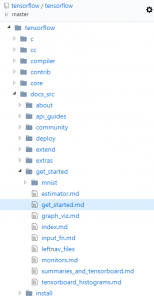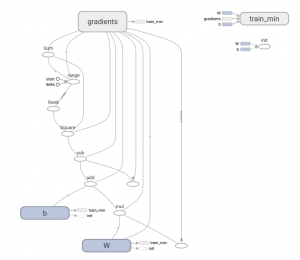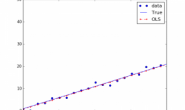TensorFlow是Google维护的一个基于数据流图的可扩展的机器学习框架,其项目地址位于 https://github.com/tensorflow/tensorflow ,我们可以从项目中找到官方的文档说明。
TensorFlow提供了多层的API接口。“TensorFlow Core”为其最底层API接口,通过它,我们能够对开发流程进行更全面的把控,而上层的API接口都是基于”TensorFlow Core”进行封装的,这样我们能对”TensorFlow Core”更快上手和使用,从而使复杂流程变得简单高效。
什么是”Tensor”
在TensorFlow中,数据的基本单位是Tensor,中文名叫“张量”,每个Tensor是由一个多维数组构成的,而Tensor的阶数,就是数据的维度。在Python语言中, 返回的Tensor是numpy ndarray对象。
比如说:
3 # 0阶Tensor,大小为[]
[1., 2., 3.] # 1阶Tensor,大小为[3]
[[1., 2., 3.], [4., 5., 6.]] # 2阶Tensor,大小为[2, 3]
[[[1., 2., 3.]], [[7., 8., 9.]]] # 3阶Tensor,大小为[2, 1, 3]
从”TensorFlow Core”入手
在TensorFlow中一系列操作可以由“计算图”表示,也就是一系列节点构成的图。程序通常被组织成一个构建阶段和一个执行阶段,在构建阶段,操作的执行步骤被描述成一个图,而在执行阶段, 使用会话执行执行图中的操作。
在图中,每个节点可以输入0或个多个Tensor,输出1个Tensor。
导入tensorflow
import tensorflow as tf
Session会话
首先,创建一个session会话,我们必须在会话中执行图:
# session
sess = tf.Session()
Constant常量与Variable变量
Constant和Variable是Tensor节点的两种类型,对应数据的常量与变量的赋值。对于变量来说,需要在会话中进行初始化才能真正赋值:
# One type of the Tensor nodes is Constant
node1 = tf.constant(3.0, dtype=tf.float32)
node2 = tf.constant(4.0) # also tf.float32 implicitly
print(sess.run([node1, node2])) # [3.0, 4.0]
# One type of the Tensor nodes is Variable
W = tf.Variable([.3], dtype=tf.float32)
b = tf.Variable([-.3], dtype=tf.float32)
init = tf.global_variables_initializer()
sess.run(init)
print(sess.run([W, b]))
# [array([ 0.30000001], dtype=float32), array([-0.30000001], dtype=float32)]
placeholder占位符
placeholder表示声明一个数据变量,而后可以定义对它的操作。在后面执行图的过程中,我们可以通过字典传参的方式将占位符赋值。
# placeholder
# A placeholder is a promise to provide a value later.
a = tf.placeholder(tf.float32)
b = tf.placeholder(tf.float32)
adder_node = a + b # + provides a shortcut for tf.add(a, b)
print(sess.run(adder_node, {a: 3, b: 4.5})) # 7.5
print(sess.run(adder_node, {a: [1, 3], b: [2, 4]})) # [ 3. 7.]
add_and_triple = adder_node * 3.
print(sess.run(add_and_triple, {a: 3, b: 4.5})) # 22.5
创建模型
我们可以定义一个模型,比如说线性模型,通过指定自变量的值,输出其对应的计算结果。
linear_model = W*x + b
print(sess.run(linear_model, {x: [1, 2, 3, 4]}))
# [ 0. 0.30000001 0.60000002 0.90000004]
评估模型
我们还可以定义一个损失函数,比如采用误差平方和(SSE)来定义损失函数,通过损失函数计算结果来判断模型的好坏。
# produce the loss value
y = tf.placeholder(tf.float32)
squared_deltas = tf.square(linear_model - y)
loss = tf.reduce_sum(squared_deltas)
print(sess.run(loss, {x: [1, 2, 3, 4], y: [0, -1, -2, -3]})) # 23.66
训练模型
TensorFlow中定义了一系列优化器,比如采用梯度下降法(Gradient Descent)来寻找损失函数最小的模型参数。
optimizer = tf.train.GradientDescentOptimizer(0.01)
train = optimizer.minimize(loss)
sess.run(init) # reset values to incorrect defaults.
print(sess.run([W, b]))
# [array([ 0.30000001], dtype=float32), array([-0.30000001], dtype=float32)]
for i in range(1000):
sess.run(train, {x: [1, 2, 3, 4], y: [0, -1, -2, -3]})
# produce the final model parameters
print(sess.run([W, b]))
# [array([-0.9999969], dtype=float32), array([ 0.99999082], dtype=float32)]
TensorBoard
整个机器学习的流程,可以通过TensorBoard可视化为下图表示。
使用上层封装API
上层封装的API能够大大简化机器学习流程,这里,我们使用“tf.estimator”来做程序示例。
数据定义
x_train = np.array([1., 2., 3., 4.])
y_train = np.array([0., -1., -2., -3.])
x_eval = np.array([2., 5., 8., 1.])
y_eval = np.array([-1.01, -4.1, -7, 0.])
input_fn = tf.estimator.inputs.numpy_input_fn(
{"x": x_train}, y_train, batch_size=4, num_epochs=None, shuffle=True)
train_input_fn = tf.estimator.inputs.numpy_input_fn(
{"x": x_train}, y_train, batch_size=4, num_epochs=1000, shuffle=False)
eval_input_fn = tf.estimator.inputs.numpy_input_fn(
{"x": x_eval}, y_eval, batch_size=4, num_epochs=1000, shuffle=False)
创建模型
创建基本的模型
feature_columns = [tf.feature_column.numeric_column("x", shape=[1])]
estimator = tf.estimator.LinearRegressor(feature_columns=feature_columns)
创建定制化模型
def model_fn(features, labels, mode):
# Build a linear model and predict values
W = tf.get_variable("W", [1], dtype=tf.float64)
b = tf.get_variable("b", [1], dtype=tf.float64)
y = W*features['x'] + b
# Loss sub-graph
loss = tf.reduce_sum(tf.square(y - labels))
# Training sub-graph
global_step = tf.train.get_global_step()
optimizer = tf.train.GradientDescentOptimizer(0.01)
train = tf.group(optimizer.minimize(loss),
tf.assign_add(global_step, 1))
# EstimatorSpec connects subgraphs we built to the appropriate functionality.
return tf.estimator.EstimatorSpec(
mode=mode,
predictions=y,
loss=loss,
train_op=train)
estimator = tf.estimator.Estimator(model_fn=model_fn)
训练模型
estimator.train(input_fn=input_fn, steps=1000)
评估模型
train_metrics = estimator.evaluate(input_fn=train_input_fn)
eval_metrics = estimator.evaluate(input_fn=eval_input_fn)
print("train metrics: %r"% train_metrics)
print("eval metrics: %r"% eval_metrics)
转载请注明:宁哥的小站 » 深度学习之TensorFlow入门





